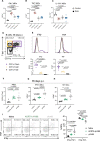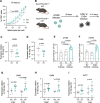Age-associated B cells are long-lasting effectors that impede latent γHV68 reactivation
- PMID: 36477199
- PMCID: PMC9729602
- DOI: 10.1038/s41598-022-25543-1
Age-associated B cells are long-lasting effectors that impede latent γHV68 reactivation
Abstract
Age-associated B cells (ABCs; CD19+CD11c+T-bet+) are a unique population that are increased in an array of viral infections, though their role during latent infection is largely unexplored. Here, we use murine gammaherpesvirus 68 (γHV68) to demonstrate that ABCs remain elevated long-term during latent infection and express IFNγ and TNF. Using a recombinant γHV68 that is cleared following acute infection, we show that ABCs persist in the absence of latent virus, though their expression of IFNγ and TNF is decreased. With a fluorescent reporter gene-expressing γHV68 we demonstrate that ABCs are infected with γHV68 at similar rates to other previously activated B cells. We find that mice without ABCs display defects in anti-viral IgG2a/c antibodies and are more susceptible to reactivation of γHV68 following virus challenges that typically do not break latency. Together, these results indicate that ABCs are a persistent effector subset during latent viral infection that impedes γHV68 reactivation.
© 2022. The Author(s).
Conflict of interest statement
The authors declare no competing interests.
Figures






Similar articles
-
Gammaherpesvirus infection drives age-associated B cells toward pathogenicity in EAE and MS.Sci Adv. 2022 Nov 25;8(47):eade6844. doi: 10.1126/sciadv.ade6844. Epub 2022 Nov 25. Sci Adv. 2022. PMID: 36427301 Free PMC article.
-
CD4 T cell control of acute and latent murine gammaherpesvirus infection requires IFNgamma.Virology. 2005 Aug 1;338(2):201-8. doi: 10.1016/j.virol.2005.05.011. Virology. 2005. PMID: 15961135
-
B cells regulate murine gammaherpesvirus 68 latency.J Virol. 1999 Jun;73(6):4651-61. doi: 10.1128/JVI.73.6.4651-4661.1999. J Virol. 1999. PMID: 10233924 Free PMC article.
-
Gamma interferon blocks gammaherpesvirus reactivation from latency in a cell type-specific manner.J Virol. 2007 Jun;81(11):6134-40. doi: 10.1128/JVI.00108-07. Epub 2007 Mar 14. J Virol. 2007. PMID: 17360749 Free PMC article. Review.
-
Unraveling immunity to gamma-herpesviruses: a new model for understanding the role of immunity in chronic virus infection.Curr Opin Immunol. 1999 Aug;11(4):371-9. doi: 10.1016/s0952-7915(99)80063-6. Curr Opin Immunol. 1999. PMID: 10448140 Review.
Cited by
-
Gammaherpesvirus infection drives age-associated B cells toward pathogenicity in EAE and MS.Sci Adv. 2022 Nov 25;8(47):eade6844. doi: 10.1126/sciadv.ade6844. Epub 2022 Nov 25. Sci Adv. 2022. PMID: 36427301 Free PMC article.
-
Age-associated B cells in autoimmune diseases.Cell Mol Life Sci. 2022 Jul 7;79(8):402. doi: 10.1007/s00018-022-04433-9. Cell Mol Life Sci. 2022. PMID: 35798993 Free PMC article. Review.
-
Age-Associated B Cells in Autoimmune Diseases: Pathogenesis and Clinical Implications.Clin Rev Allergy Immunol. 2025 Feb 17;68(1):18. doi: 10.1007/s12016-025-09021-w. Clin Rev Allergy Immunol. 2025. PMID: 39960645 Free PMC article. Review.
-
Impact of Epstein-Barr Virus Nuclear Antigen 1 on Neuroinflammation in PARK2 Knockout Mice.Int J Mol Sci. 2024 Oct 4;25(19):10697. doi: 10.3390/ijms251910697. Int J Mol Sci. 2024. PMID: 39409029 Free PMC article.
-
Combination of proviral and antiviral roles of B cell-intrinsic STAT1 expression defines parameters of chronic gammaherpesvirus infection.mBio. 2024 Nov 13;15(11):e0159824. doi: 10.1128/mbio.01598-24. Epub 2024 Oct 23. mBio. 2024. PMID: 39440973 Free PMC article.
References
-
- Dong S, Forrest JC, Liang X. Murine gammaherpesvirus 68: A small animal model for gammaherpesvirus-associated diseases. In: Cai Q, Yuan Z, Lan K, editors. Infectious Agents Associated Cancers: Epidemiology and Molecular Biology. Springer; 2017. pp. 225–236. - PubMed
Publication types
MeSH terms
LinkOut - more resources
Full Text Sources
Molecular Biology Databases
Research Materials

